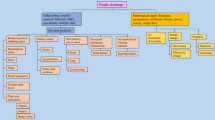Abstract.
Nipple discharge disorders is a field in which there has been both increasing awareness on the part of patients and advances in management. Today secretion from nipples can be classified according to its color, cellularity and biology. To be significant a discharge should be true, spontaneous, persistent and non-lactational. Moreover there are methods to differentiate patients who require surgical intervention from those who do not. Surgically significant nipple discharges are watery, serous (yellow), serosanguineous and bloody. Cytology smears of discharge material have helped to classify the cellular material, providing information about normality, atypia and malignancy and also about papillary formation of the exfoliated cells. Tests such as Hemoccult help to discover occult blood in the secreted fluid. Modern immunological tests can be performed on cytology smears where occurrence of high levels of carcinoembryonic antigen could indicate a latent malignancy. Galactography investigation is today the state-of-the-art approach to investigate patients with nipple discharge disorders and this examination can demonstrate the size, location and extent of an intraductal abnormality. Modern high-resolution ultrasound techniques are helpful in visualizing intraductal disorders and are becoming a good complementary approach if not an alternative to traditional radiology techniques. Recently even MR galactography has been shown to be of diagnostic value, but not as informative as regular galactography. The most sophisticated investigation method, which can also be used therapeutically, is fiber-ductoscopy of the concerned duct in a breast. This technique, although expensive and in its infancy, is a fascinating and promising approach for inspecting the intraductal lumina. In this article the background, current investigation methods and possibilities of the technique are described, as well as the most sophisticated ways to deal with nipple discharge disorders in human breasts.
Similar content being viewed by others
Author information
Authors and Affiliations
Additional information
Received: 25 March 1998; Revision received: 27 July 1998; Accepted: 29 July 1998
Rights and permissions
About this article
Cite this article
Okazaki, A., Hirata, K., Okazaki, M. et al. Nipple discharge disorders: current diagnostic management and the role of fiber-ductoscopy. Eur Radiol 9, 583–590 (1999). https://doi.org/10.1007/s003300050715
Issue Date:
DOI: https://doi.org/10.1007/s003300050715




